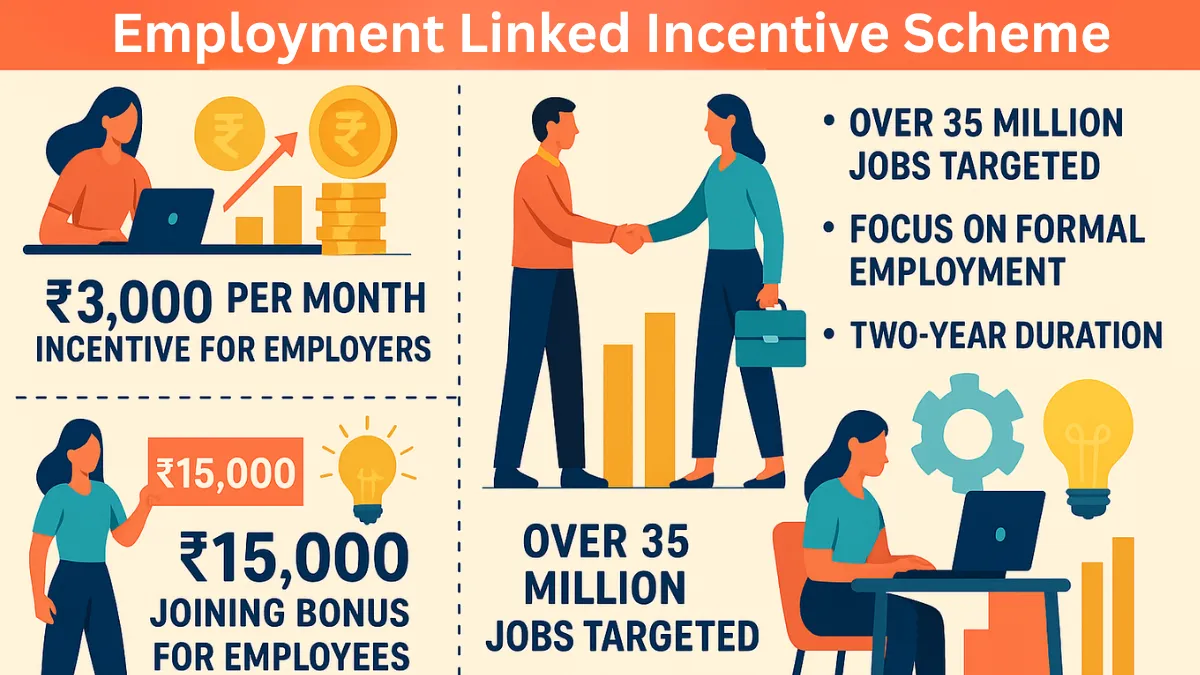The Employment Linked Incentive Scheme, launched by the Government of India in July 2025, marks a transformative approach to tackling unemployment and promoting workforce formalization across the country. With a massive outlay of ₹1 trillion (approximately $11.7 billion), the ELI scheme aims to generate over 35 million new jobs within a two-year period. More than just a subsidy plan, the scheme symbolizes India’s commitment to building a resilient and inclusive economy driven by employment, enterprise, and empowerment.
The Vision Behind the Scheme: Employment Linked Incentive Scheme
India has long grappled with the twin challenges of unemployment and an overwhelmingly large informal workforce. Despite rapid economic growth, a significant portion of India’s labor force remains outside the formal sector, devoid of social security, healthcare, and job stability.
The ELI Scheme seeks to reverse this trend by encouraging companies to create new jobs, rather than simply filling existing vacancies. It links direct fiscal incentives to actual employment growth, making it one of the most outcome-focused labor reforms in India’s history.
What the Scheme Offers
The ELI scheme is structured around two key incentive channels—one for employers and one for employees:
For Employers:
- ₹3,000 per month incentive for each new employee retained beyond six months.
- Applicable for jobs created in sectors like manufacturing, textiles, MSMEs, logistics, electronics, and green energy.
- Employers must be registered with the EPFO and GSTN, and demonstrate net job creation (i.e., not job replacement).
For Employees:
- A one-time joining incentive of ₹15,000 is credited directly to the bank accounts of eligible new employees.
- To qualify, workers must be between 18–45 years old, earning below ₹25,000/month, and not employed in the formal sector for the previous 12 months.
- Special incentives exist for women, differently-abled, and workers from disadvantaged backgrounds.
Implementation Strategy
The Ministry of Labour & Employment will oversee the program through digital platforms such as the National Career Service (NCS) and the Skill India Digital Portal. Employers need to submit monthly reports to validate job creation and retention. Data will be cross-verified with EPFO payroll filings and Aadhaar-based identity systems to ensure transparency and curb fraud.
Each employee retained beyond six months qualifies the employer for monthly subsidies for up to 24 months. The system encourages long-term hiring, not just temporary or seasonal employment.
Targeted Sectors
To maximize impact, the ELI Scheme focuses on labor-intensive and growth-ready sectors:
- Textiles & Apparel: High employment potential with large informal labor bases.
- MSMEs: Backbone of Indian economy; often constrained by hiring costs.
- Green Economy: Renewable energy, battery assembly, EV manufacturing.
- Logistics & Warehousing: Fast-growing sector with national infrastructure push.
- Electronics Manufacturing: Boosting “Make in India” while absorbing youth workforce.
Why This Scheme Matters
- Boosts Formal Employment:
By incentivizing EPFO-registered jobs, the scheme pushes informal jobs into the formal sector, increasing workers’ access to PF, insurance, and job benefits. - Supports Businesses:
Particularly helpful for startups and MSMEs, which often delay hiring due to high labor costs. The scheme lowers the financial barrier to expansion. - Encourages Youth Employment:
With India’s large young population, the ₹15,000 joining incentive serves as a strong motivation for first-time job seekers. - Inclusion of Marginalized Groups:
Extra support for hiring women and differently-abled workers promotes diversity and equity in the labor market.
Public and Industry Reactions
The ELI scheme has been met with praise from economists, industry leaders, and labor unions alike. Employers appreciate the direct cash support, while social advocates highlight the scheme’s role in expanding formal labor rights.
“This scheme is timely and much needed. It strikes a balance between job creation and accountability,” says Ankita Sinha, HR head at a Bengaluru-based MSME.
“It’s a win-win—workers get financial support and benefits, while employers are rewarded for hiring,” comments Ravi Sharma, labor policy expert.
Challenges Ahead
While the policy framework is promising, the success of the ELI Scheme will depend on:
- Effective monitoring and audits to prevent fake employment claims.
- Timely disbursement of funds to both employers and workers.
- Awareness campaigns so small businesses and job seekers know how to enroll.
- Integration with skilling initiatives to ensure new hires are job-ready.
Conclusion
The Employment-Linked Incentive Scheme could be a landmark reform in India’s employment landscape. By financially rewarding job creation and worker retention, it aligns national economic goals with individual empowerment. In a country with millions seeking dignified work, the ELI scheme offers hope, opportunity, and structure—exactly what a forward-looking economy needs.
If implemented with clarity, transparency, and inclusiveness, the ELI Scheme won’t just create jobs—it will transform livelihoods, strengthen industries, and energize India’s march toward becoming a truly employment-rich economy.








